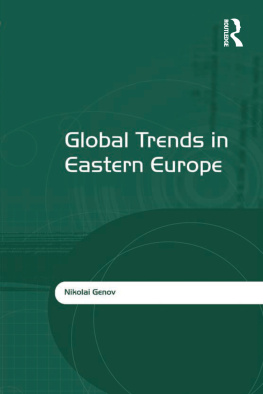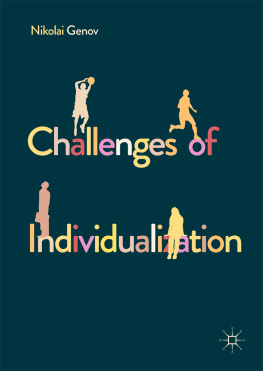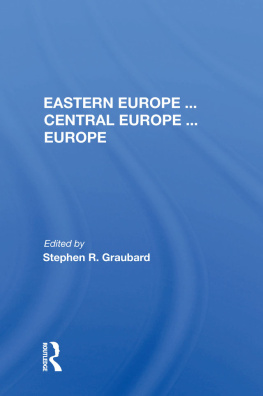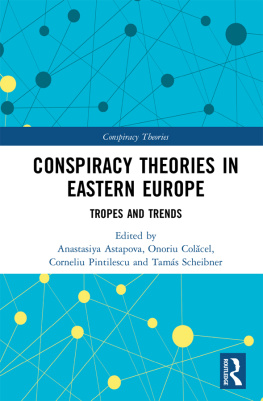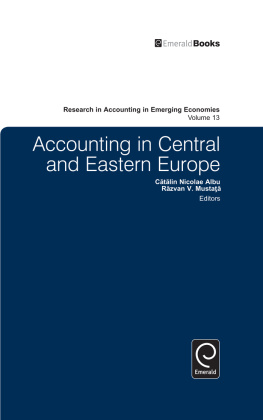First published 2010 by Ashgate Publishing
Published 2016 by Routledge
2 Park Square, Milton Park, Abingdon, Oxon OX14 4RN
711 Third Avenue, New York, NY 10017, USA
Routledge is an imprint of the Taylor & Francis Group, an informa business
Copyright Nikolai Genov 2010
Nikolai Genov asserted his right under the Copyright, Designs and Patents Act, 1988, to be identified as the author of this work.
All rights reserved. No part of this book may be reprinted or reproduced or utilised in any form or by any electronic, mechanical, or other means, now known or hereafter invented, including photocopying and recording, or in any information storage or retrieval system, without permission in writing from the publishers.
Notice:
Product or corporate names may be trademarks or registered trademarks, and are used only for identification and explanation without intent to infringe.
British Library Cataloguing in Publication Data
Genov, Nikolai.
Global trends in Eastern Europe.
1. Europe, Eastern--History--1989- 2. Europe, Eastern-- Social conditions--1989- 3. Social change--Europe, Eastern. 4. Globalization--Social aspects--Europe, Eastern.
I. Title
303.4'0943-dc22
Library of Congress Cataloging-in-Publication Data
Genov, Nikolai.
Global trends in Eastern Europe / by Nikolai Genov.
p. cm.
Includes bibliographical references and index.
ISBN 978-1-4094-0965-6 (hardback) -- ISBN 978-1-4094-0966-3 (e-book)
1. Globalization--Europe, Eastern. 2. Europe, Eastern--Politics and government--1989- 3. Social change--Europe, Eastern. 4. Europe, Eastern--Social conditions--1989- 5. Cultural pluralism--Europe, Eastern. 6. Europe, Eastern--Economic conditions--1989- I. Title.
JN96.A58G46 2010
303.48'247--dc22
2010017092
ISBN 9781409409656 (hbk)
ISBN 9781315585031 (ebk)
Preface
There was once a world region called Eastern Europe. It was clearly defined by the centralized political and economic organization of the societies in the region. They shared the same official ideology and were members of the same economic, political and military alliances. The region was diplomatically recognized and geo-strategically respected. It was a key international player in the divided world which emerged after the Second World War. On both sides of the polar division many experts believed that this situation would last for long. They assumed that the change could only be the result of war. It was supposed to be a nuclear war.
To the great surprise of millions, the global region Eastern Europe disappeared as quickly as Atlantis. The cataclysm was not due to natural but to historical forces. However, it was no less spectacular, for Eastern Europe disappeared as a global actor in a peaceful manner. It collapsed in an economic, political and cultural implosion. What were the moving forces of this profound change on the world map? How did the historical cataclysm happen? What are its consequences 20 years later? Could we try to reasonably foresee any future developments in the former global region?
The present monograph is an effort to answer these questions in a theoretically coherent and empirically sound way. The guiding assumption of the analysis and argumentation is that at the end of 1980s the integration mechanisms in Eastern Europe could no more resist the overwhelming power of global trends. It was the hasty adaptation to these trends which made up the essence of the societal transformations in the region. Consequently, what we observe today is a large variety of more or less successful societal adaptations to these global trends. The process continues. Many options for change are still open.
The global trends to be analyzed in this book are called upgrading the rationality of organizations, individualization, spread of instrumental activism, and universalization of value-normative systems. These concepts were initially elaborated and applied in the small monograph Managing Transformations in Eastern Europe. It was commissioned by the MOST Program of UNESCO and published in 1999. The monograph was dedicated to the tenth anniversary of the fall of the Berlin Wall and to its consequences for the Eastern European societies. The general assessment of the situation in the region could only be rather critical at that time. After ten years of reforms most Eastern European societies were still far from the level of GDP which they had in 1989. Apart from a small group of central-east European countries, large parts of the former region were politically unstable. Disappointments were strong. Values and norms were in flux.
The situation changed rapidly between 2000 and 2008. This short period was the success story of globalization. The GDP growth of most Eastern European societies reached and exceeded their GDP level before the changes. The economic recovery was accompanied by the stabilization of political institutions. These used to be still characterized as imperfect, defect or show-case democracies. But in the history of most Eastern European countries they were the first democratic political institutions ever. The value-normative re-integration celebrated real achievements. Millions of Eastern Europeans could enjoy the rise in living standards and the practical relevance of universal human rights. The critical stance which marked the monograph of 1999 seemed to be questioned by the social processes.
This experience made the need to re-think the Eastern European transformations an urgent task. The intellectual process was facilitated by my move to the Free University in Berlin. The detailed study of changes in Eastern Europe became my professional obligation. The conclusion of the studies was unmistakable: Eastern Europe had joined the achievements of globalization but also the global accumulation of tensions and conflicts. These intensified as a result of the lost correspondence between the financial markets and the real economy of goods and services, between the globalization of markets and the striking delay in the development of global governance, between the rapidly growing global demands and the fragility of the global environment.
It seemed that the looming economic, political and cultural challenges might initially explode in the weakest parts of the global interconnections. Eastern Europe could be the first region struck by the coming global crisis. Contrary to this assumption, the pattern of 1929 was repeated. The crisis struck the most powerful economy in the world first. The effects irradiated from the centre of the world economy towards the Eastern European periphery. Several national economies went bankrupt there. The consequences of this development will be probably far reaching.
Thus, the work in the laboratory Eastern Europe became highly intriguing once more. The conditions for precise analyses are favorable now. Today we possess better elaborated concepts and reliable empirical information. Social scientists are aware of the way in which globalization works and about its consequences. Nevertheless, the cognitive challenges are tremendous: What is the impact of the new regional divisions on the continuing societal transformations? What can be achieved in the social science explanation and prognostication of societal development in the context of global trends? The present monograph is the result of efforts to connect questions and answers concerning two turning points in the European and global development the crisis and renewal around 1989 and the new challenges 20 years later. The structure of the analysis and argumentation is transparent. In contains conclusions which are relevant to the development of social science knowledge as well as to the study and management of social development.

